A Summer Favorite
Blue claw crabs are popular local fare in coastal New Jersey; be sure to prepare and eat them “Jersey style.”
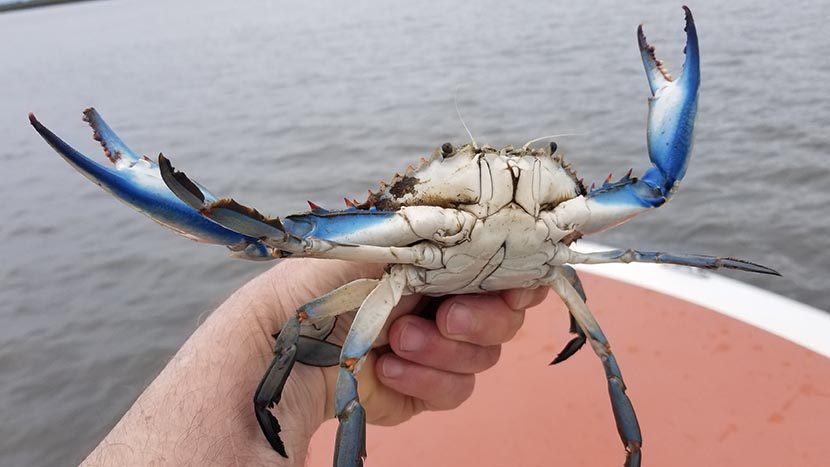
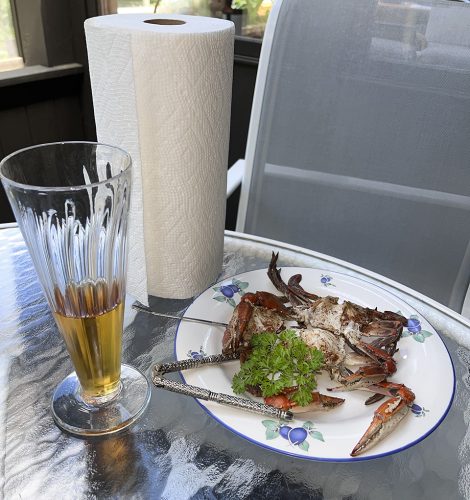
When waters have remained warmer over the winter as in this year, our Memorial Day tradition is to have our first blue crab supper on that holiday. Crabs will be more plentiful and larger in August, but a long winter without crabs gives us a hankering to kick the summer off with a seafood feast. This year we joined the Taylors at their home in Newport.
Back in July 2019 I wrote a story that focused on the natural history of the blue claw crab and my childhood of catching and cooking crabs; it was called Coastal Delicacy (available on SNJ Today’s website – https://snjtoday.com/coastal-delicacy/). This time I would like to look at the southern New Jersey tradition of eating cleaned crabs, jawing, and then I’ll share some recipes.
I’m Italian by marriage, and when in Rome (or Vineland) you do as the Romans do. After 44 years of wedded bliss I sometimes have to remind myself of my Spanish and German heritage. South Jersey Italians (and most South Jersey folks) do not eat crabs like Marylanders; that is far too messy and uncivilized. We eat our crabs “Jersey Style;” in Maryland and Delaware real crab eaters don’t clean them first. And when in Maryland do as… In New Jersey it is also traditional to eat spaghetti with clam sauce before eating the crabs.
Jersey Style means we remove the back carapace from the crab, pull off its lungs, and hose the “innards” out before we cook them. Marylanders, on the other hand, cook them whole and clean them on their plate, often finding the “mustard” tasty (“mustard” being the yellowish guts).
In my opinion, once you are spoiled by having crabs cleaned beforehand you’ll prefer them that way. This is a continual source of argument between me and my friend from Maryland. The debate of how to properly prepare crabs can be a cause for “fightin’ words.”
Speaking of trash talk, the Bayshore Center in Bivalve used to hold a Bay Day Festival, and part and parcel of that event was a crab-picking contest. This involved seeing who could pick the most crabs in a given amount of time. A professional picker is often a shaker, holding the crab and forcing the meat out with an abrupt snapping of the wrist, which is a great way to earn a hospital pass for a carpal tunnel operation.
On the other hand, at the Bayshore contest most folks were knifers, scooping the crab out from its individual segments using a small blade. Intrinsically attached to the atmosphere of the competition was trash talking. I was pretty sure I could win at one thing or the other, so I entered each year. I never remember producing the most crab meat, but I do think I talked my way into being loathed or admired for the greatest amount of nonsense spoken. And my meat was shell-free and not mashed, an accomplishment in itself. You may be getting insight into the focus of my banter: “Come on, you expect someone to eat that? How are they supposed to get it past their eyes?”
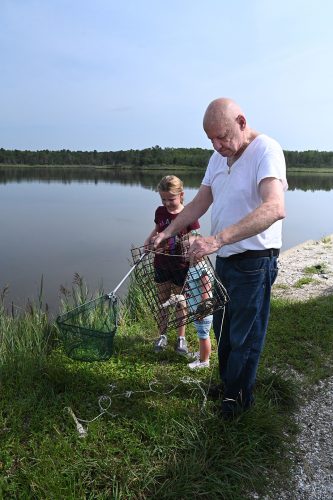
At our homestyle crab feasts the dinner table conversation involves storytelling: Bayshore storytelling. Our host Stultz Taylor enjoys talking about growing up on the New Jersey Delaware Bayshore, primarily in Port Norris. He spent his high school years oystering on Hal Bickings’ boats and working in his shucking house, “Peterson Packing.” Senior year Stultz got half-day work privileges because he had accumulated enough credits to graduate without having to attend school for the full day. In the 1970s he witnessed a major change, from lots of deck hands sorting oysters to the implementation of culling machines on deck, which are still in use today.
Prior to the installation of culling machines the only significant innovation was the shift from sails to diesel engines in 1945. Before the war motors were prohibited for the harvesting of oysters but afterwards, because of reduced manpower, they were finally allowed. Culling machines were introduced circa 1975. These are mechanical tumblers and conveyor belts that separate the broken shells and dump them back into the water, work formerly done painstakingly by hand. The conveyors stack the whole oysters in front of the wheelhouse, and then transport them to the wharf when the boat returns to off-load at port. Culling machines made it possible to reduce the crews from 14 men to four.
Ship carpenter and culling machine fabricator Louis Peterson described the apparatus to historian Patricia Moore (interview cataloged with the National Marine Fisheries Service 2/2/2023).
“It was made with staggered bars, one inch apart. They found out that shells was less than an inch and oysters was over an inch. So the oysters would stay in the cage, but the shells would fall through and go out the pipe,” he related.
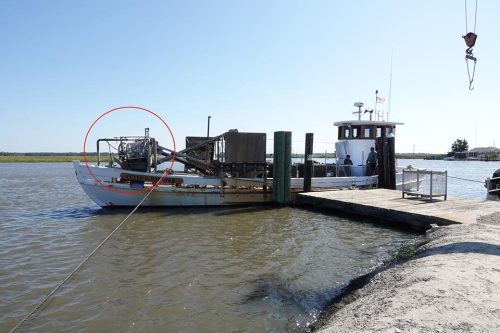
Bob Morgan of Dorchester Shipyard told me in the 1980s that he and Luther Jeffries pioneered the use of the culling machine. Jeffries returned to the family business of oystering after several years as a nuclear engineer, and he and Morgan designed this innovation. Louis Peterson also talked about their collaboration and his own fabrication of the cullers.
Watching an oyster boat get off-loaded this past year I saw them use large square containers and a crane to remove the bivalves. Innovations are continually made in the oyster industry, but eating an oyster stays pretty much the same.
While cracking crabs during our recent feast Stultz also reminisced about hanging out by the Methodist Church at North Avenue and Main with his pals when Lou Perry, whose father Hal owned a fish wholesaler and store in Bivalve, would ask, “Wouldn’t you fellows prefer fishing to standing around doing nothing?” Within a few hours they would be filling drums with weakfish for market. Perry used to unload his catch at Long Reach Marina across from his business.
Today Stultz still fishes, but for recreation. And he often tells stories about his trips aboard the Bodacious with Captain Tim Smith as we dine on crabs, clams, and oysters at his home or ours. The mix of present and past days makes for fun dinnertime conversations.
Eating crabs is as much about talking as eating. And with the right people you can learn a lot of history!
Blue Claw Crab Recipes
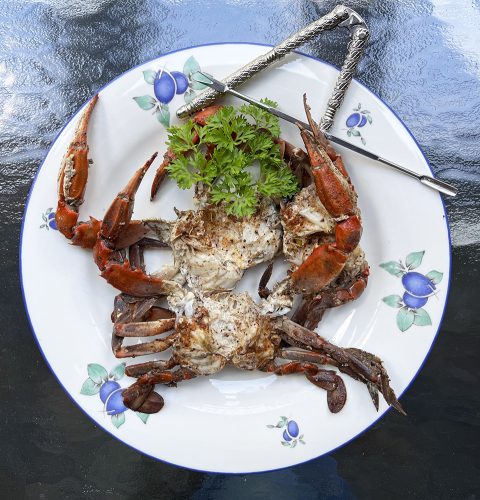 Following are some crab recipes. Both Dad’s Seafood in Vineland and Jenkins Seafood in Newport will sell cleaned crabs if you prefer not to take on the task. Bailey’s in Port Elizabeth sells whole crabs.
Following are some crab recipes. Both Dad’s Seafood in Vineland and Jenkins Seafood in Newport will sell cleaned crabs if you prefer not to take on the task. Bailey’s in Port Elizabeth sells whole crabs.
The easiest way to prepare crabs is to steam them. Choose the crab seasoning you like. Some well-known brands are Old Bay, Wry River, and O.J. No 2 Crab House Spice. O.J. sticks to the crabs better while Wry River is more peppery. Using a large steamer pot, place the crabs one layer at time, sprinkling each with the seasoning; I prefer less to more. Put two inches of water in the bottom of the pot and pour in a bottle of beer. Steam until the crabs are red.
Clam Sauce for Spaghetti
(traditionally eaten before crabs)
Cook until soft in 10 qt. pot:
- 3 large Vidalia onions, chopped
- Cloves of garlic, chopped
- ¼ lb. of butter
- 2 tbsp. of olive oil
- Add 2- 3 lbs. cans of chopped sea clams
Heat to a boil, reduce to a simmer, then add:
- 1-2 cups chopped curly parsley
- Simmer for 1-2 hours
Pour over 2 lbs. of spaghetti to cover, and then spoon the clams from the bottom of the pan over the top of the pasta.
Garnish with fresh ground pepper and sprinkle three-cheese grated Italian cheese (parmesan, asiago and Romano). There should be extra sauce for leftovers and for spooning some clam on the top of individual servings.
The next two recipes are my mother-in-law’s; she did not measure, and neither do I, so you can adapt to your own tastes.
Oven-Baked Crabs with White Sauce
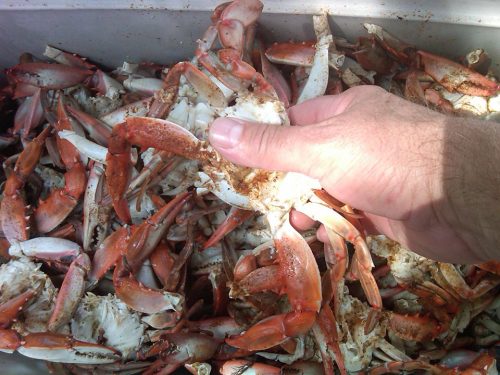
(Mom Galetto’s recipe given to us 7/28/86)
- 1 bushel or 8 doz. crabs
- 1 lb. bacon
- 1 lb. butter
- 4 medium onions chopped
- 8 cloves garlic- minimum
- 1/3 cup white vinegar x2
- 2/3 cup water x2
- Finely chop: basil 1/2c – 1 cup
- Fresh curly parsley 1 cup
- celery 1 cup
- fresh sage ½ cup
Finely chop and fry bacon; drain off fat. Add butter and melt.
Add onions and garlic and cook.
Add vinegar and water.
Pour over crabs, salt and pepper them, and sprinkle herbs.
Arrange crabs in one or two layers in an oven-proof dish (aluminum is fine), approx. 19.5 x 11.5.
Cook in oven at 375° F. until crabs are red; it may take an hour depending on the number and how cold the crabs are.
Note: Recipe can be made with two dozen crabs; half or quarter recipe and use ¼ lb. of butter. The liquid should be about half-way up the crabs.
The recipe has always been made more by eye than measuring.
Mom’s Red Sauce Crabs
- Take 2 dozen crabs
- 1/3 lb. salt pork chopped fine and cooked in ¼ cup olive oil
- Cool the above
- Add 6-7 cloves of garlic chopped (not minced) browned in above
- 2 28-oz. cans all-purpose crushed tomatoes, we recommend San Marzano (or whole tomatoes in blender)
Mix and add:
- 1/2 can tomato paste (optional)
- 6 oz. water
- Large bunch of parsley – minced
- 1/3 cup basil
Let cool for an hour. Then cook crabs in boiling spaghetti sauce and remove crabs. Then pour sauce over two lbs. cooked spaghetti.









